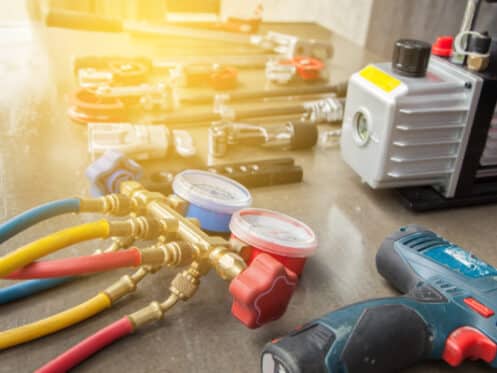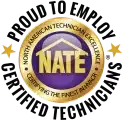An HVAC tune-up is a routine maintenance procedure during which a technician inspects your system and ensures that it’s in good condition and operating efficiently. Heating and cooling tune-ups are typically seasonal in nature. In other words, if you schedule a tune-up in the fall, the focus of that service appointment will be your furnace or heat pump and the other aspects of your HVAC system related to it. We recommend seasonal tune-ups because they’re required by your HVAC warranty, extend the life of your equipment, and lower your heating and cooling costs on a month-to-month basis.
Multipoint Inspection
A key element of any HVAC tune-up is the multipoint inspection, which will vary not only based on the configuration of your system but the age, make, and model of your equipment. Your technician will have an inspection checklist specific to your home or business and can typically provide you with a copy. The technician will then identify all of your equipment and confirm that it is installed according to the manufacturer’s specifications. The next phase is to ensure that all of the components are operating within acceptable parameters and to pinpoint any wear and tear that needs to be corrected. Be mindful that the inspection will be completed over various stages rather than all at once. There is, for instance, a pre-inspection necessary to ensure that it’s safe for the technician to enable the system. Once the system is running, the technician can verify that the components are operating as they should.
Comprehensive Cleaning
Another important aspect of an HVAC tune-up is cleaning the equipment. Particularly with forced-air systems, there is a great deal of dust that accumulates. There’s often grim accumulation as well due to grease and other residues mixing with dust and other particles. Typically, much of the dirt that builds up will be removed using a commercial-strength vacuum cleaner. Your technician will also hand clean where necessary and use a commercial degreaser in order to remove the grime.
Lubricating Moving Parts
There are many moving parts within your HVAC system, ranging from the air handling unit to the furnace or air conditioner. That movement creates friction and resulting heat. Grease is applied to those moving parts in order to mitigate how much wear is caused during normal operation. However, grease breaks down over time and needs to be replaced. Your technician will first clean these parts in order to remove the old lubricant. Once removed and the parts cleaned and dried, the technician will apply new grease so that the moving parts operate efficiently throughout the upcoming season and with minimal wear.
Check and Tighten All Electric Connections
Other aspects of your HVAC system prone to wearing down over time are the electrical connections. The technician will check the control boards and other circuit boards in order to make sure that they’re operating within normal limits. It’s also necessary to test the connections. Electrical connections loosening over time isn’t unusual. The tech will tighten any connections that require it, and over an extended period, it may become necessary to replace parts like connections, wires, and capacitors.
Other Correction of Wear and Tear
There is a wide range of components within an HVAC system that need to be checked and may need to be adjusted or even replaced. This includes all motors and belts. Your technician will ensure that the condensation line is draining appropriately and clean it out as needed. A tune-up involves checking the coils and typically cleaning them with a cleaning agent specifically designed for coils. The technician will also inspect the fins on the outdoor unit and straighten any that are bent.
Refrigerant Level Check
If you’re having an air conditioning tune-up performed, it’s also necessary to have the refrigerant level checked. The refrigerant level generally shouldn’t drop in a well-functioning AC. If it does, it may indicate a major leak, which should be fixed right away. It can also indicate small leaks in the coils due to corrosion, which should also be fixed.
HVAC Filter Replacement or Cleaning
Your HVAC system has at least one and potentially multiple supply vents, which is where the air from inside the home or business is returned to be cooled or heated. Those vents have filters in order to prevent large particulate matter from getting into the system, and it’s recommended that you replace them on a regular basis and usually no longer than every three months. Most HVAC companies replace the filters as a courtesy during a tune-up whether needed or not. If your system has reusable filters, then your technician will clean them instead and also assess the overall condition of the filter.
System Performance Check
Once satisfied that your system has passed the pre-inspection, the technician will turn the system on and run the heat or air conditioning. Any testing that needs to be performed while the components are running will then be carried out. The technician will then check all of the return vents in order to ensure that the static pressure within the system is appropriate.
Thermostat Calibration
At this point, your technician will inspect and clean your thermostat. This usually involves removing the faceplate, brushing dust out of the unit, and checking and testing the electrical connections. Your technician will compare your thermostat reading to the reading provided by their equipment. If adjustment is needed, the tech will enter calibration mode on the unit and adjust it.
Health Report for the Customer
When the normal tune-up procedures are complete, your technician will provide you with a status report concerning your equipment. This will generally involve a health report on the various components and details about what to expect going forward. It’s also an opportunity to ask any questions that you may have. Note that your technician may also recommend proactive repairs. While these aren’t required and will cost extra, they’re advisable since they’ll help avoid a system failure in the future and will save you money over the long term. If you choose to have the repairs performed, the technician will usually conduct them during that same appointment.
HVAC Service Order and Repair Invoice
Finally, your technician will provide you with a service order and, if applicable, a repair invoice. This is much more than just a bill and receipt. It’s proof that you’ve had routine maintenance performed. File it away with your records. In the event that something does go wrong with your HVAC system and you need to make a claim on your warranty, the manufacturer may request this paperwork.
HVAC Tune-Up Specialists Serving Greater San Antonio
Air Authority, A Riteway Service Company is an HVAC company that has served San Antonio and the surrounding areas for many years. Our company belongs to ACCA and TACCA, and all of our HVAC technicians are NATE certified. Count on us for seasonal HVAC tune-ups, which we perform for furnaces, boilers, heat pumps, air conditioners and ductless and ducted mini-split systems. We also install and repair all manner of heating and cooling technologies, clean ductwork, and install and service indoor air quality equipment. Call Air Authority, A Riteway Service Company today or contact us online to schedule a tune-up or to request more information about any of our residential or commercial services.





